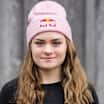
You set a new personal record in Glasgow with a time of 60m 57s. Can you tell us how you first got into HYROX?
This February marked exactly two years since my first HYROX, which was a big milestone for me! Before HYROX, I was just a runner. I did lots of club running cross-country and a little bit of track. I left school and I was in London and I'd go to some fitness classes like Barry's Bootcamp-type thing, just to have some fun as a social thing, to try and meet some friends in London.
One day someone said to me, “well, you' a really good runner and you're quite strong as well at all the exercises and lifting. Have you heard of HYROX? And I’d have no idea what it was, no idea! I’d never seen it, never heard about it. I did some research and found out that actually within the London scene a lot of people were already doing HYROX.
I thought this looks really cool, I'm just going to give it a go. So I signed up to Glasgow last minute - and I instantly thought, this is insane! The noise in the venue still remains one of the loudest, the best event vibe I'd ever been to. From there, I was certain: I want to do this!
Did you start in the Open or Pro Division at HYROX?
I started with the Open Division. Glasgow was my first race, and then I also did London that year. There, I qualified for the World Championships in Glasgow. It was Manchester hosting that year, which was really cool obviously to compete on home turf. At the World Champs in Manchester everybody had to compete in the Pro Division.
I remember because I was in the in the Doubles Division too and we also had to do the the heavier weights. That was my first Pro experience – and I was really not prepared. I don't think anything can prepare you for how those pro weights feel on the first time you do them. No matter if you've trained with heavier weights - nothing can actually prepare you for how hard that action is.
Nothing can really prepare you for how Pro weights feel first time you do them
Do you ever miss your running career or are there things that you can use from that experience for HYROX?
I don’t really miss track so much, I found a lot of pressure on the track and I didn't particularly enjoy the shorter distances. I do sometimes miss cross-country. I think it’s great training and it's a great background to have for HYROX. I've always been more of an endurance athlete, which really goes well with HYROX – and HYROX is where I belong.
I’ll occasionally do a road race as well, like a 10k or a half marathon - especially in my off season.
How was it for you to quit your job at such a young age to pursue a career in HYROX?
At 20, I knew if there was ever a time to go for it, it was now. I was burning out trying to balance work and training, and even my bosses encouraged me to pursue being a professional athlete. My family and friends gave me the final push, especially with the World Championships coming up in three months. I went all in, and it paid off – now I’m sponsored by Red Bull and other amazing brands. It still doesn’t feel real, but it’s an absolute dream come true.
What's been your most memorable moment in HYROX so far?
Two key moments stand out for me. The first was winning my age group at the World Championships – it wasn’t just about winning, but winning by nearly three minutes. I had trained harder than ever before, fully committing as if I were already a professional athlete. That victory showed me what was possible if I went all in.
The second was competing in Nice. Even though it wasn’t home turf, the support was unreal, and the energy from the crowd was incredible. That race gave me the confidence to believe I could make it into the Elite 15 if I kept working hard. It felt like a turning point, where I truly started seeing myself as an elite competitor.
I’m not one of those athletes who wake up at 5am to train
What does a typical training day look like for you?
A typical day for me starts around 7 or 8am - I prioritise sleep, so I’m not one of those athletes who wake up at 5am to train. After a solid breakfast, I hit the gym by 9am, which is great because most people working 9-to-5 have already left. My biggest session of the day is in the morning, usually focused on running - either an easy run, intervals, or threshold work.
Midday is often spent on recovery, admin work, media commitments, or even squeezing in a quick nap if needed. Then, around 3 or 4 PM, I start my second session, which might be strength training, station-specific work (like the ski erg), or an easy session on the bike or rower. This session is usually lower intensity or recovery-based.
Evenings are for winding down—having a big dinner, resting, and making sure I get enough sleep to be ready for the next day. It’s all about consistency and balancing intense training with proper recovery.
How much of your training is running versus strength work?
Running makes up about 40-50 percent of my weekly training hours, but that’s just pure running. Since HYROX is an endurance sport, aerobic training is key, but too much running can lead to fatigue or injury. There’s a point where the returns diminish, so instead of overloading on miles, I balance it with other aerobic activities like cycling.
A great tip I’ve learned is that if I need more aerobic work beyond a certain amount of running, I switch to the bike. For example, I might run for 40 minutes to an hour and then continue my session on the bike. This keeps my endurance high without putting excessive strain on my joints.
A lot of my training focuses on zone 2 work rather than high-intensity sessions. When I first started, I made the mistake of doing intense compromised running sessions almost every other day, which led to extreme fatigue. Now, I’ve learned that a smarter, more balanced approach leads to better long-term results.
Do you have a favourite HYROX workout that improves your fitness the most?
I love my threshold running sessions – they make a huge difference to my fitness. HYROX is such a running-dominant sport now, and being a strong runner can save so much time. For example, in a recent race, I came out of the SkiErg in 14th place but made up 12 seconds on the next run and moved up to 6th, eventually leaving the sled push in 4th. That’s how much of an impact running has.
One of my favorite sessions is a mix of tempo running, EMOM (Every Minute on the Minute) workouts, and station work. I actually had a great session like that this morning—it was my first hard session back after a race. These kinds of workouts are tough but fun, with lots of volume, and even though they last around two hours, they fly by because they keep you engaged.
How do you pace yourself in a HYROX race?
Pacing is absolutely crucial in HYROX. The first kilometre is always fast, so I use the SkiErg as a chance to regather myself and prepare for the rest of the race. In my last race, I intentionally skied slower, which dropped me from 4th to 14th place, but I knew I’d make up ground later. That said, to reach the podium in elite races, I need to find a way to keep my ski and row pace higher without increasing effort.
It’s a fine balance – you can’t just go all out and expect to hold on. My heart rate is in zone 4 for nearly the entire race, which only happens in competition. I also realised I was saving too much for the wall balls, where I ended up feeling really strong. That taught me I can afford to push harder earlier. Ultimately, it’s all about managing effort at different points in the race to maximize performance.
What advice would you give to someone doing their first HYROX?
Pacing wisely is one of the most important things for a first-time HYROX athlete. When beginners ask for my top three tips, my number one is always: don’t go out too hard. It’s so tempting to push right from the start, but the best thing you can do is keep the SkiErg at an easy pace.
It took me almost 10 races to truly learn this. Winning the SkiErg won’t win you the race—unless you’re exceptionally strong on it. In most age-group races, the person who finishes the SkiErg first rarely wins overall. A great approach is to hold back in the first half of the race, especially on machines like the Ski Erg and Row Erg. If you get to the Burpee Broad Jumps or the row feeling good, you can push much harder in the second half, knowing you’re close to the finish.
On the other hand, if you go too hard in the first half, you’ll be dragging yourself through the rest of the race, which makes it mentally and physically exhausting. It’s about knowing your limits—find a sustainable effort early on so you have the energy to attack later. For me, I’m working on bringing my ski pace down from 2:05 per 500m to something faster, but I know I have to do that without overexerting myself too soon. It’s all about playing the long game!
What are your long-term goals in HYROX?
Breaking the one-hour mark is a big goal for me – I know I’ll do it one day, it’s just a matter of when. Maybe next year, maybe in two, but it’s definitely possible.
Beyond that, my main focus is staying in the Elite 15, which is tough because the rankings are so competitive. In the short term, I’d love to podium at a major event, and long-term, my ultimate dream is to win a major and eventually a world title. I’ve got plenty of time to make it happen, so I’m excited for the journey ahead!
What's the community like in HYROX, especially among elite athletes?
The HYROX community is amazing. Even though we're all racing to beat each other, there's so much mutual respect. I was nervous at first, thinking it might be more competitive or hostile, but it's the complete opposite. Everyone supports each other, especially when things get tough. We check in on athletes who DNF, make sure everyone’s OK and celebrate each other’s successes.
I’ve made great friends, like Joanna [Wietrzyk], and it’s nice knowing we’re in this sport together for the long run. It’s just so refreshing to have athletes genuinely congratulate each other, regardless of results. Everyone’s happy to see each other succeed, and it creates such a positive, supportive environment, which is really special as the sport grows. It feels great to be part of such a unique and welcoming community!










